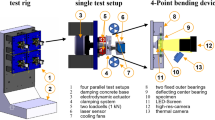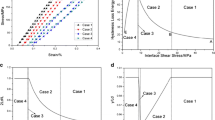Abstract
Residual stresses and strains are present in composites where the constituent materials have different thermo-elastic properties. Upon cooling from the processing temperature these stresses develop as a consequence of the mutual restraint of the constituents on each other’s thermal expansion or contraction. The magnitude of the residual stresses depends on the degree of load transfer, on the amount of mutual restraint characterised by the thermal expansion mismatch, and on the elastic moduli of the constituents. In composites reinforced by continuous fibres, the residual stress state is characterised by the axial stresses in the fibre and the matrix, and by the radial stress perpendicular to the fibre-matrix interface. The latter affects the degree of load transfer between the fibres and the matrix and hence also influences the magnitude of the axial residual stresses.
When the composite is mechanically loaded, the applied stresses superimpose on the residual stresses and together they determine the mechanical response. As long as their combined effect does not trigger additional irreversible damage within the composite, the residual stress state remains unchanged. When damage accumulation (matrix cracking, interfacial debonding, fibre failure) occurs upon loading the residual stresses are relieved and their effect on the mechanical response decreases. However, for brittle matrix ceramic composites where the matrix has a lower failure strain than the fibres, this stress relief is not always possible. Indeed, when the axial residual stresses in the fibres are tensile, residual stress relief results in closure of the matrix cracks. This generates a mechanical incompatibility which prevents additional relief upon further interfacial debonding and leads to an intensification of the effect of residual stresses. The presentation gives some examples of both cases.
Access this chapter
Tax calculation will be finalised at checkout
Purchases are for personal use only
Preview
Unable to display preview. Download preview PDF.
Similar content being viewed by others
References
Marshall, D. B., Shaw, M. C. and Morris, W. L. (1985) The determination of interfacial properties from fibre sliding experiments, Acta Metall Mater. 43, 2041.
Singh, R. N. and Reddy, S. K. (1996) Influence of residual stresses, interface roughness and fibre coatings on interfacial properties in ceramic composites, J. Am. Ceram. Soc. 79, 137.
Hsueh, C.-H. (1993) Evaluation of interfacial properties of fiber-reinforced ceramic composites using a mechanical properties microprobe, J. Am. Ceram. Soc. 76, 3041.
Clyne, T. W. and Phillips, A. J. (1994) Interfacial control and macroscopic failure in long-fibre-reinforced and laminated inorganic composites. Comp. Sci. Technol. 51, 271.
Majumdar, S., Singh, J. P., Kupperman, D. and Krawitz, A. D. (1991) Application of neutron diffraction to measure residual strains in various engineering composite materials, Journal of Engineering Materials and Technology 113, 51.
Steen, M. (1997) submitted for publication.
Steen, M. (1995) Residual stress state and damage mechanisms in ceramic matrix composites inferred from uniaxial tests incorporating unloading and reloading sequences, Fourth Euro Ceramics 3, 61–70
Steen, M. (1996) Tensile mastercurve of ceramic matrix composites: significance and implications for modelling, International Workshop on Modelling of the Mechanical Behaviour of Continuous Fibre reinforced Ceramic Matrix Composites, Petten, sept. 1996.
Steen, M. and Valles, J. L. (1997) Interfacial bond conditions and stress distribution in a 2D-reinforced brittle matrix composite, Composites Science and Technology, in print.
Rouby, D. and Reynaud, P. (1993) Fatigue behavior related to interface modification during load cycling in ceramic-matrix fiber composites, Composites Science and Technology 48, 109.
Steen, M., Vallés, J. L. and Lamouroux, F. (1995) Fatigue and creep damage mechanisms in a 2D Al2O3(f)/SiC composite, NATO Advanced Study Institute course on Mechanical Behaviour of Materials at High Temperature, Sesimbra, Portugal, sept. 1995
M. Steen and J. L. Vallés (1996) Time and cycle dependence in high temperature fatigue of ceramic matrix composites, ASME Turbo Expo ’96, ASME paper number 96-GT-532.
Author information
Authors and Affiliations
Editor information
Editors and Affiliations
Rights and permissions
Copyright information
© 1998 Kluwer Academic Publishers
About this chapter
Cite this chapter
Steen, M. (1998). Effect of Residual Stresses on the Mechanical Response of Continuous Fibre Reinforced Ceramic Matrix Composites. In: Haddad, Y.M. (eds) Advanced Multilayered and Fibre-Reinforced Composites. NATO ASI Series, vol 43. Springer, Dordrecht. https://doi.org/10.1007/978-94-007-0868-6_19
Download citation
DOI: https://doi.org/10.1007/978-94-007-0868-6_19
Publisher Name: Springer, Dordrecht
Print ISBN: 978-94-015-3940-1
Online ISBN: 978-94-007-0868-6
eBook Packages: Springer Book Archive




